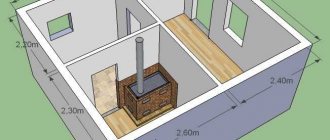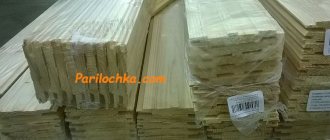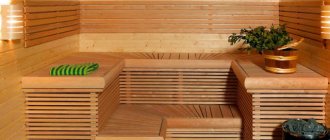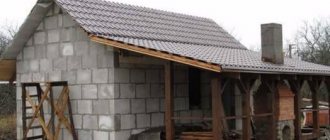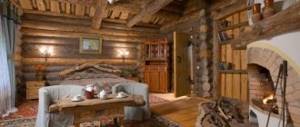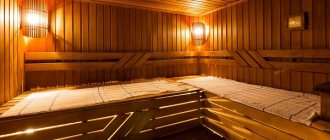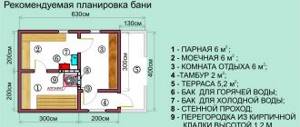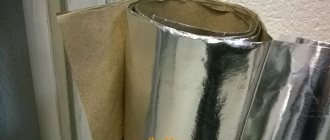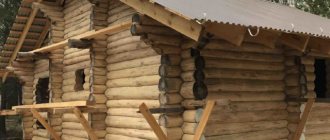Material selection
For a steam room in a bathhouse, it is better to make the finishing from lining, for the manufacture of which various types of trees were used. Lining is an edged profiled board with grooves in it. It is quite often used for exterior and interior decoration.
This material is not only convenient and practical to use, but also has a number of advantages:
- Environmentally friendly and safe.
- Has a long service life. With proper care, it will last from 10 to 15 years.
- Depending on the chosen type of wood, it may have medicinal properties, so you can also focus on healing.
- Hypoallergenic.
- The structure of the material is optimal for finishing rooms with high levels of humidity, as it quickly absorbs and releases moisture.
- There is a huge selection of colors on sale. This makes it possible to choose the appropriate option and refuse to color the material, which can be harmful to human health.
- Availability.
Considering the available advantages of this material, most people prefer it.
Today on the market there is lining made from different types of trees. Therefore, before choosing one or another, it is necessary to study the characteristics and properties of each of them.
Lining for finishing a steam room can be made from the following tree species:
- Pine – its advantage is its low cost. At high temperatures, it releases resin, which is harmful to the human body. It is used for finishing steam rooms in which low-power electric heaters are installed.
- Cedar is a rather expensive but sought-after material. Cedar is a coniferous tree, but unlike pine it does not emit resin in large quantities. Has a pleasant smell.
- Birch is not the most suitable option for finishing baths. This is due to the fact that the material made from this tree is characterized by significant shrinkage.
- Larch – does not change its properties when in contact with moisture. It is distinguished by density and durability. Its porous structure does not change its properties during sudden temperature changes. The variety of shades of larch material and its natural shine make it popular for finishing baths. The disadvantage may be processing difficulties.
- Aspen is an affordable material that tolerates high temperatures quite well. It is resistant to moisture, so there is no need to worry about cracks. This wood is called a natural antiseptic, as it resists the formation of bacteria, fungi and mold on the surface.
- Alder is a relatively expensive material that is often used for lining a steam room. Its popularity is associated with its advantages - attractive appearance, good thermal insulation, unobtrusive, pleasant smell when heated.
- Linden is the best option for a steam room. It has attractive light shades. The peculiarity of this material is its slow heating, and this can protect bathhouse visitors from burns. The advantages include the fact that linden reacts well to moisture and practically does not deform. But linden is picky when it comes to care. Its absence will lead to the fact that after a year the lining will lose its presentable appearance.
- Oak is a strong and durable cladding. The disadvantages of oak are its cost and difficulties associated with processing.
In order to ensure quick heating of the room and to protect the walls from overheating, it is recommended to use lining made of deciduous trees. There is no need to skimp on material. After all, covering the steam room with clapboard is done for a long time.
Important! The most suitable tree species for the steam room are linden and alder.
Recently, most people use thermal wood to decorate the steam room in the bathhouse. This is a high-quality and environmentally friendly material, processed with hot steam (190–220 degrees).
The advantages of thermowood are:
- Low thermal conductivity.
- Improved hydroscopic properties - the material does not absorb moisture and does not rot.
- Characteristic brown-golden color.
- Lack of special care.
When choosing a material, you need to pay attention to its grade. For a steam room, it is better to use wood of the first or highest grade. This material is of high quality, there are no knots, nicks or irregularities on its surface, which means its service life will be long.
Imitation of larch timber for baths and saunas
Imitation of larch timber is a universal finishing material.
The use of imitation larch timber is practiced in all regions of Russia, in various types of finishing. For baths and saunas, this material is quite good, as it has good resistance to power, is not afraid of hot steam and temperature changes from minimal to high. Imitation larch timber can compete with aspen lining or linden lining. This finishing material is used for covering dressing rooms, external decorative finishing and other auxiliary works. Imitation larch timber
Installation
A steam room covered with clapboard is beautiful, fast and inexpensive. This material provides a locking system (tenon and groove), thanks to which it will be possible to assemble all the parts in a short time, while the gaps will be minimal. The lining is attached to a wooden sheathing using self-tapping screws, nails or clamps.
In what sequence is the lining of a steam room in a bathhouse performed:
- Lathing. Non-planed boards and slabs are suitable for its installation. The sheathing will not be visible. The selected material is attached to the wall perpendicular to the direction of the lining (steps from 50 to 60 centimeters). The sheathing is fastened to a wall made of brick, concrete or stone using screws with plastic dowels, and to wooden walls - with galvanized self-tapping screws.
- Insulation . The optimal material for this would be basalt wool. Plates of wool are placed between the beams of the sheathing. It is necessary to ensure that no gaps are formed, otherwise the bath will not retain heat well.
- Vapor barrier . Its task is to prevent the accumulation of moisture in the insulation and reduce thermal conductivity. At this stage, strips of glassine or other material for vapor barrier are attached horizontally over the sheathing with insulation using a furniture stapler (from bottom to top). In this case, each subsequent strip should overlap (about 5 centimeters) with the previous one. All strips must be glued using adhesive tape or wide tape.
- Installation of lining . It is better to start attaching it from the most inaccessible corner.
Installation of the lining can be carried out in two ways:
- Vertical.
- Horizontally.
In the case of vertical fastening, you may encounter the appearance of fungus. It can be triggered by the fact that the board is heated unevenly. The temperature is higher at the top and lower at the bottom. In addition, the lower part suffers more from humidity.
Despite the above disadvantages, there is also a relative advantage - a low risk of gaps. The reason for this is the uniform deformation of all boards.
With horizontal installation, the risk of deformation of the lining is significantly lower. This is due to the fact that each board is located in a certain temperature zone. When installed horizontally, the upper boards experience greater shrinkage than the lower ones. This can lead to seams coming apart.
Installation of beacons - how to do it in log and lumber
The finishing of a wooden bathhouse begins with lining and tiles - this is the most suitable option for beautiful room cladding. Installation begins with wall sheathing, which consists of wooden or metal slats, called beacons, and self-tapping screws. The frame makes all subsequent work easier, allowing you to lay beautiful tiles on the floor and cover the walls with neat clapboard.
When lining the bathhouse, during lathing, a level and a pencil will be indispensable. Decide on the direction of the lining and its location - horizontal or vertical. When the work plan has been outlined, you need to draw the walls and begin installing the beacons.
General concepts
When finishing a bathhouse with wood, special limiting strips are used to cover the lining - installation takes a lot of time, but subsequent work goes quickly, and the end result is pleasing. Most often, beacons made of aluminum or wood are installed on walls - beacon slats. When lining a bathhouse from the inside, this design has a number of advantages:
- Can be mounted on walls without any problems;
- Fastened with self-tapping screws, nails, dowels;
- Can be purchased at any building materials store;
- Immediately after completion of installation, you can proceed to the final stage of cladding the walls of the bathhouse;
- During the installation process, you first need to mark the markings with a level and a pencil, and then simply screw on the frame of the beacons.
Floor and ceiling finishing
The ceiling in the steam room can also be covered with clapboard. The same material option as for the walls is suitable for this. This will preserve the overall concept and give integrity to the steam room, creating a cozy atmosphere.
The floor in the steam room is the place that is least exposed to high temperatures. To set it up you need:
- Clay layer (concrete screed).
- Fiber zinc.
- Treated board or ceramic tiles.
Advantages of shrinkage construction
Shrinkage is the natural process of wood decreasing in size with the gradual removal of moisture. The timber sauna is assembled under the roof and left for up to 1 year to allow drying to complete naturally. During this time, all wooden elements will take on their final dimensions, and it will be possible to move on to the final stage of finishing the premises.
Construction for shrinkage is a long option; it will be possible to complete the finishing and use the bathhouse only a year after assembling the box and installing the roof. However, this construction option continues to be in demand for several reasons:
- Higher reliability. During natural drying, moisture is removed more evenly, so there will be significantly fewer cracks in the walls. The timber will not deform, the walls will remain smooth.
- Economic benefit. If there is no urgent need for a bathhouse, you can wait for the shrinkage to complete and save significantly on building materials.
- Fewer one-time expenses. You can plan the construction and finishing budget for the next year to reduce the burden on the family budget.
- Finishing will not take much time. Smooth timber walls look beautiful on their own and retain heat well.
A properly assembled wooden building can stand for a long time after assembly without finishing, so you can gradually complete the finishing work and prepare it for use.
What should care be like?
It is not recommended to use painted boards for finishing the steam room. Also, they cannot be coated with varnish or stain. At high temperatures, such products will release harmful substances.
In order for the clapboard finishing of the steam room to please the eye for as long as possible, you need to properly care for it:
- Ventilate and allow to dry after each heating.
- Warm up the steam room to at least 70 degrees.
- In winter, cool the steam room to minus temperature.
It is recommended to periodically treat the steam room lining with oils. Both hemp, flaxseed and regular vegetable oil are suitable for this. They can be used pure or mixed with a few drops of essential oils. Using this method, it will be possible to polish the lining, give it shine and imbue it with an aroma, which will intensify at high temperatures.
If you properly care for the cladding and follow these recommendations, it will last for a long time. At the same time, it will not be spoiled by fungus or mold, and there will be no foreign odors in the bathhouse.
Important! Using oils to process the lining will allow it to remain clean for a long time.
What to do while the bathhouse frame is settling?
The main rule is not to change the design of the bathhouse. After each intervention, the log house will again change its height. For example, if you installed a roof, then after a while the bathhouse will change its height by several centimeters. After caulking the space between the logs, the bathhouse will first “grow” in height and then decrease in size again. Thus, if you definitely decide to let the log house mature, you do not need to make changes to its design. Before starting the standing period, complete the following work:
- Foundation installation. In loose soil, swampy soil, and in the presence of groundwater, the foundation can experience significant shrinkage. Accordingly, the walls will also move from their place, and the height of the log house will change.
- Roof installation. The roof structure for a bathhouse is a so-called “roofing pie”, which turns out to be quite heavy. The newly installed structure puts pressure on the logs, and therefore the height of the log house decreases.
- Caulking walls. This is a necessary event for a log house. Without caulking, there will be gaps between the logs through which cold air will penetrate. Such a bathhouse does not retain heat, so you will not be able to fully steam in it. Also, without a sealant, moisture penetrates into the cracks, which negatively affects the overall condition of the log house.
Only after this can the countdown begin. An ordinary log house lasts 15 months. If you do not wait this time, the installed windows and doors will warp, and the interior decoration of the bathhouse will lose its attractiveness.
